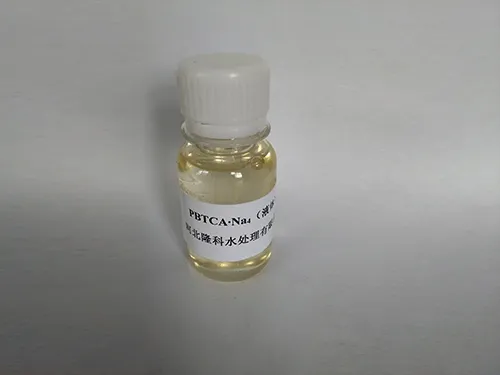The Science Behind Organic Phosphonates in Water Treatment
Efficient water treatment solutions are essential for industries worldwide, and the role of organic phosphonates in this domain cannot be overstated. Compounds like 2-phosphonobutane-1,2,4-tricarboxylic acid (PBTC) and its derivatives, including PBTC·Na4, offer advanced capabilities in scale inhibition, corrosion control, and system efficiency. By leveraging their unique chemical properties, industries can enhance sustainability and operational performance, all while minimizing environmental impact.

Exploring the Role of 2-Phosphonobutane-1,2,4-Tricarboxylic Acid
2-phosphonobutane-1,2,4-tricarboxylic acid is a powerful organic phosphonate widely used in water treatment applications. Its primary function is to inhibit scale formation, particularly in environments with high concentrations of calcium, magnesium, or other scaling ions. The compound’s robust stability at high temperatures and varying pH levels makes it an excellent choice for challenging industrial conditions.
One of the standout features of PBTC tricarboxylic acid is its low threshold dosage, which means even small quantities can effectively prevent scale buildup. This efficiency reduces chemical consumption, leading to cost savings and less environmental waste—a critical advantage in industries aiming to adopt greener practices.
PBTC·Na4: A Versatile Solution for Industrial Systems
The sodium salt derivative of 2-phosphonobutane-1,2,4-tricarboxylic acid, known as PBTC·Na4, offers additional versatility. It demonstrates excellent compatibility with other water treatment agents, enhancing the overall efficacy of multi-functional formulations. This property makes PBTC·Na4 a preferred choice for applications requiring tailored solutions, such as in cooling towers, boilers, and reverse osmosis systems.
By integrating PBTC·Na4 into water treatment processes, industries can achieve superior corrosion control. The compound acts by forming a protective layer on metal surfaces, reducing the risk of damage caused by aggressive water conditions. Its use extends the lifespan of industrial equipment, ensuring long-term operational efficiency.
The Environmental Benefits of Organic Phosphonates
Unlike traditional water treatment chemicals, organic phosphonates like 2-phosphonobutane-1,2,4-tricarboxylic acid are biodegradable and exhibit low toxicity. These properties make them environmentally friendly alternatives for industries seeking sustainable solutions.
In addition to their eco-friendly nature, organic phosphonates enhance the quality of discharged water. By preventing scale and corrosion, these compounds reduce the release of harmful metals and minerals into the environment. This aligns with global efforts to minimize pollution and protect aquatic ecosystems.
The Science Behind Scale and Corrosion Inhibition
The molecular structure of 2-phosphonobutane-1,2,4-tricarboxylic acid provides unique advantages in scale inhibition. Its multiple carboxylic groups form strong bonds with scaling ions, effectively preventing their crystallization. This process ensures smooth system operations, even under conditions where scaling potential is high.
Additionally, PBTC tricarboxylic acid exhibits excellent thermal stability, allowing it to maintain its performance at elevated temperatures. This property is especially valuable in industries such as power generation and petrochemicals, where systems often operate under extreme heat.
In terms of corrosion control, the phosphonate group in PBTC·Na4 interacts with metal surfaces to form a protective barrier. This barrier prevents the penetration of corrosive agents, reducing wear and tear on equipment and minimizing maintenance costs.
Choosing the Right Organic Phosphonate for Your Needs
When selecting a water treatment solution, understanding the specific properties and applications of organic phosphonates like 2-phosphonobutane-1,2,4-tricarboxylic acid and PBTC·Na4 is crucial. Industries must consider factors such as water composition, operating conditions, and environmental regulations to determine the most effective compound for their systems.
For instance, PBTC·Na4 is ideal for systems requiring high compatibility with other chemicals, while 2-phosphonobutane-1,2,4-tricarboxylic acid excels in environments with severe scaling and corrosion challenges. Both options provide reliable performance and contribute to the sustainability of water treatment processes.
Organic phosphonates, particularly 2-phosphonobutane-1,2,4-tricarboxylic acid and its derivative PBTC·Na4, represent a significant advancement in water treatment technology. Their ability to inhibit scale and corrosion, coupled with environmental benefits, positions them as essential tools for modern industries. By incorporating PBTC tricarboxylic acid and other organic phosphonates into their systems, industries can achieve improved efficiency, reduced operational costs, and a smaller environmental footprint. These compounds not only address current challenges but also pave the way for more sustainable and effective water treatment practices in the future.
-
Understanding Polycarboxylic Acids: Properties, Applications, and Future PotentialNewsJul.28,2025
-
Scale Inhibitor Explained: How to Protect Your System from Limescale and Hard Water DamageNewsJul.28,2025
-
Scale and Corrosion Inhibitors: Essential Chemicals for Industrial Water System ProtectionNewsJul.28,2025
-
Polyaspartic Acid: A Biodegradable Polymer for Sustainable ChemistryNewsJul.28,2025
-
Isothiazolinones: A Versatile Antimicrobial Class with Industrial Power and Regulatory ChallengesNewsJul.28,2025
-
A Deep Dive into 2-Phosphonobutane-1,2,4-Tricarboxylic Acid (PBTC)NewsJul.28,2025





